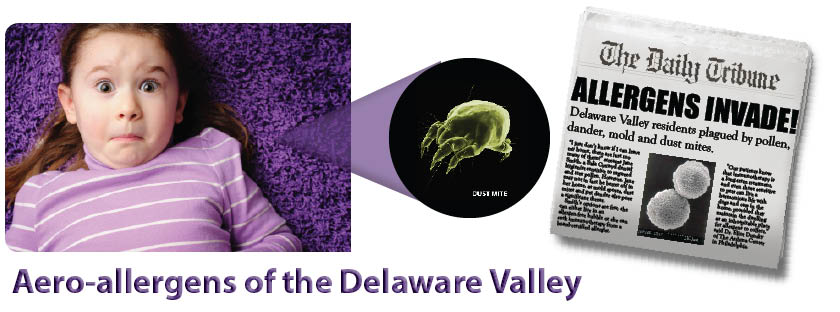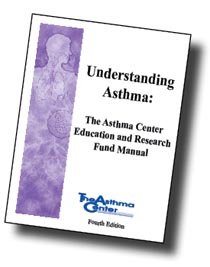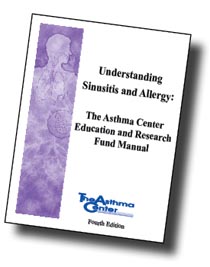Environmental Avoidance of Allergens and Irritants
Printable PDF
Common sources of environmental allergens:
House dust mites | Cockroaches | Chemical fumes | Carpeting | Furniture | Pets | Air conditioning | Bedroom | Air ducts | Water sources
Aerobiology is the study of airborne particles that cause allergic reactions in sensitized persons. Typical reactions include respiratory (allergic rhinitis/sinusitis & asthma), cutaneous, or conjunctival allergy. About 25% of Americans are affected.
Aeroallergens include pollen grains, biogenic waste, mold spores, and occupational allergens. Clinically significant aeroallergens are proteins or glycoproteins with a molecular weight of 10,000 to 60,000 Daltons. They include airborne concentrations of particles, which are buoyant and able to travel long distances when propelled by wind.
In general, Anemophilus or wind-pollinated plants cause outdoor allergy symptoms from the spring through the fall. Physicians at The Asthma Center conduct daily monitoring of pollen and mold spores as part of an ongoing project since 1990. The Asthma Center’s pollen center is certified by the National Allergy Bureau of the American Academy of Asthma Allergy and Immunology. Sampling devices include the Burkard Spore Trap and the Rotorod Rotating Arm Impactor located at The Asthma Center’s Philadelphia and Cherry Hill, New Jersey offices. See our the Delaware Valley's current allergen report for more information.
THE ALLERGENS
Pollen grains are living male gametophytes (sperm) of plants. Individual pollen grains that cause allergy are microscopic in size and not visible to the eye. Ragweed is about 20µ in diameter; tree pollen is 20-60µ; and grass pollen is 30-40µ. Pollen is collected, stained and identified microscopically at pollen stations throughout the U.S.
High volumes of pollen are produced annually. A single ragweed plant can produce one million pollen grains in a single day. Some trees (conifers, for example) can release so much pollen that the microscopic grains form a cloud and can form a visible carpet on the ground.
Most pollen is released early in the morning. Temperature, humidity, rain and wind affect airborne pollen concentrations. Pollen grains released by flowering plants are usually large and heavy, unlike tree, grass and weed pollen. Consequently, pollen grains from flowering plants are usually too heavy to be carried by the wind and are rarely a problematic aeroallergen. In contrast, the tiny ragweed pollen is so light that it can be transported hundreds of miles by the wind and has become one of the most significant sensitizing aeroallergens.
TREE POLLEN
Our data indicate that the local spring tree season begins in early March and extends through May. The most common groups of tree pollens measured in our area include juniper, cedar, maple, elm, oak, birch, pine, and mulberry. Minor tree pollen groups include alder, ash, walnut, sweet gum, sycamore, poplar, willow and linden. Individual trees pollinate for two- to three-week intervals, but not necessarily at the same time. These intervals overlap most often in the spring. Also, changes in weather can extend the pollen season.
GRASS POLLEN
The grass season starts in late-April and ends in late July. The highest pollen counts of the year are measured in May, sometimes exceeding 1000 grains/m3 of air per 24 hours.
Many grass pollen share the same allergen and therefore, if you are allergic to one type of grass, you’ll probably have similar symptoms around most other grass pollen.
It is very difficult to identify specific species of grass using the light microscope. The most common grass pollens identified in the Northeast include Kentucky bluegrass, fescues, ryegrass, orchard grass, redtop grass, Johnson grass, timothy grass and vernal grass. In recent years, we have observed a second minor grass season in the fall from late August to September.
WEED POLLEN
The fall pollen season is distinctive in its variety of allergenic plants. Although it is traditional for the ragweed season to begin on August 15th, our data indicate that the first ragweed pollen is seen in the first week of August and extends to the end of October.
Ragweed, including the short and giant species, is considered the most important allergenic weed in North America with an enormous output of pollen grains per plant. If there is significant spring rainfall, it is known that ragweed will produce more pollen in the fall. In addition, temperatures above 60 degrees Fahrenheit, low humidity, and light intensity influence the ragweed pollen levels.
Our data indicate the peak for ragweed pollen in the Delaware Valley to occur from September 7th to September 20th annually. Other significant weed pollens found on our pollen collections include sage, lambs quarter, English plantain, yellow dock, sheep sorrel, nettle and pigweed. Elm tree and grass pollen have also been seen in September for many years. The fall weed season ends abruptly with the first hard frost, which comes as a great relief to fall allergy sufferers.
OUTDOOR MOLD (fungi)
Outdoor fungi are also called field fungi and thrive on plants decaying in the soil. Their spores are released in the highest numbers between the spring and fall, when humidity is high.
Mold spores are widespread throughout the Delaware Valley. Our data shows that spores form the majority of biologic particles in the air. Although mold spores can be found in the air throughout most of the year, we have found that the highest mold spore counts can reach up to 10,000 spores/m2, and this peak occurs between July and December. Mold spores can cause typical respiratory allergic symptoms. However, they are also can induce hypersensitivity, pneumonitis, bronchopulmonary aspergillosis and fungal sinusitis.
Mold exposure is associated with a variety of allergy symptoms. One study indicated that children exposed to fungal spores had a 10% to 30% increase in asthma symptoms for every 1000 spores/m3 of air. Another study revealed emergency room visits in New Orleans to be associated with elevated Basidiospore levels. This and other data provide the basis for established levels of 1000 spores/m3 or greater of outdoor air exposure as a cause of allergic symptoms.
The most common mold spores that are seen in our area include Alternaria, Cladosporium, Ascospores, Basidiospores, Epicoccum, Pithomyces, and Smuts. Minor species seen include Rusts, Botrytis, Cercospora, Curvularia, Drechslera, Oidium, Polythrincium, Stemphylium, and Torula. Unidentified mold spores on specimens are seen regularly as well. In general, high spore levels occur with rainfall, fog, and nighttime damp conditions. The wet weather spores are Ascospores and Basidiospores while the dry weather spores are Alternaria, Cladosporium, Epicoccum and Drechslera.
INDOOR MOLD
Aspergillus and Penicillium are often referred to as “storage fungi” since they grow on dead and dying stored grains, rotting fruits and vegetables. These fungi on stored items in basements will appear as green mildew. Black-colored fungi is associated with Rhizopus and Stachybotrys.
INDOOR ALLERGENS
Dust mites are highly allergenic and cause significant symptoms of allergic rhinitis, sinus disease and bronchial asthma.Dust mites (Dermatophagoides, pternonyssinus and D. farinae) are the major allergen in indoor dust. They are tiny (.33 mm) barely visible, eight-legged insects. They eat human skin, animal dander, fungi and anything rich in protein. High humidity and warm temperatures allow dust mites to thrive.
Dust mites are found at their highest concentration in the temperate zones—particularly in people’s beds. They have an affinity for materials such as bedding, drapes, carpets and upholstery. In fact, dust mites are often most numerous right under your nose, as your head rests on your pillow.
German cockroaches are common in cities when apartments are heated. They produce potent allergens that are associated with asthma. Dog and cat dander occur through desquamation of skin. It is ongoing, and therefore animal dander accumulates in homes of pet owners in great amounts unless pet owners thoroughly clean their home and use air cleaners to remove aerosolized dander.
Dander is skin flakes that contain highly allergenic, water-soluble proteins. Cat dander contains the potent Fel d 1 allergen, while dog dander contains the Can f 1 and Can f 2 allergens.
Animal dander often remains in homes for many months, leading to persistent symptoms long after the pet’s removal. Further, dander can remain in air ducts or walls and hidden areas for years.
Rodents secrete allergenic protein in their urine which, when dried, becomes a potent aerosolized sensitizer that can affect laboratory workers as well as warehouses workers.
Allergy to horses, cows, goats, and sheep are often considered occupational allergens. Even rabbits, gerbils, hamsters, guinea pigs, rats and mice produce dander that can induce allergy symptoms.
OUTDOOR POLLUTION
Outdoor pollution worsens allergy symptoms.
- Carbon monoxide
- Lead
- Nitrogen dioxide
- Ozone
- Sulfur dioxide
- Particulate matter
*The Asthma Center collects pollen data beginning in March and ending in November.
ALLERGY TESTING
Allergy skin testing is still the most sensitive way to determine an individual’s hypersensitivity to an allergen. One advantage is that skin testing shares the same exact allergens used in immunotherapy, assuring that the treatment program incorporates all essential allergens. For further info about allergy skin testing, visit asthmacenter.com.
PREVENTION/MANAGEMENT
Air cleaners
HEPA air filters are much more effective than ion-generating air purifiers. Vacuuming carpets, furniture, textiles and draperies keep dust mite populations low. HEPA filters on vacuums are necessary to prevent escape of dust mites back into the home. It’s more effective to provide a thorough cleaning once a week than a light cleaning once a day. Be sure to vacuum mattresses and padded furniture thoroughly.
Dust mite control:
- Encase mattress, pillow and quilt in dust-mite-proof covers.
- Wash bedding weekly in very hot water to kill dust mites.
- Minimize upholstered furniture.
- Replace curtains with blinds.
- Reduce indoor humidity to below 50% with dehumidifier.
- Thoroughly vacuum weekly.
Pet allergen control:
- Keep pets out of bedrooms, off furniture.
- Wash bedding once a week in very hot water.
- Bathe pet once a week.
- Clean carpets with HEPA vacuum.
Mold control:
- Reduce indoor humidity (to less than 50%).
- Use HEPA filters to remove airborne mold.
- Wash mold-infested surfaces with mold killer or inhibitor.
- Ventilate all indoor areas.
- Use hardwood floors, no rugs.
- Clean heating and cooling equipment.
Cockroach control:
- Remove food and water sources.
- Use pesticide bait traps.
- Wash down surfaces, floors and walls with detergent.
- Seal cracks in walls, floors and molding.
Humidity control:
- Ventilate closed spaces (e.g. basements)
- Seal basement floor.
- Prevent basement moisture with a dehumidifier.
- Control basement flooding with a French drain and sump pump.
IMMUNOTHERAPY
Of all the therapies offered for respiratory allergy, injection therapy or immunotherapy is perhaps the most specific and effective treatment available in preventing recurrent symptoms in a hypersensitive patient. However, immunotherapy is only effective if the offending allergens are identified and incorporated into the allergy serum in adequate concentrations. Half-measures often prove inadequate in stubborn cases. A careful and comprehensive allergy history and skilled allergy testing are the basis for an effective treatment program.
Allergy injection treatment is carried out over a long period of time (3 - 6 years in most cases). At first, patients receive weak solutions of allergens. The dose is then gradually increased to induce tolerance without reactions. The goal is to achieve a high enough maintenance dose which affords the best symptom relief. Improvement in symptoms usually lasts for years after completing a successful course of allergy injections.
Sub-lingual immunotherapy is not currently FDA-approved, and we cannot recommend this treatment at this time.
OCCUPATIONAL ALLERGENS
Allergic reactions to aerazolized allergens in the workplace may result in occupational disability. Identification of occupational allergy early in its development may prevent permanent lung damage and long term disability.
Although most allergy sufferers experience symptoms at home or outdoors, a smaller group of these individuals encounter potent allergens at work. Knowledge of potential workplace allergens can lead to early detection of occupational allergic disease. At first, symptoms might be mild, but they can progress to produce severe allergies—including permanent lung damage. These allergens are often unique to specific occupations and therefore, one must always consider the workplace as a source for aeroallergen exposure.
.jpg)
REFERENCES
“A Comparative, Volumetric Survey of Airborne Pollen in Philadelphia, Penn. (1991-1997) and Cherry Hill, NJ (1995-1997). Annals of Allergy, Asthma and Immunology. D. Dvorin, MD; J. Lee, MMS; G. Belecanech, MD; M. Goldstein, MD; Eliot Dunsky, MD.



.jpg)

